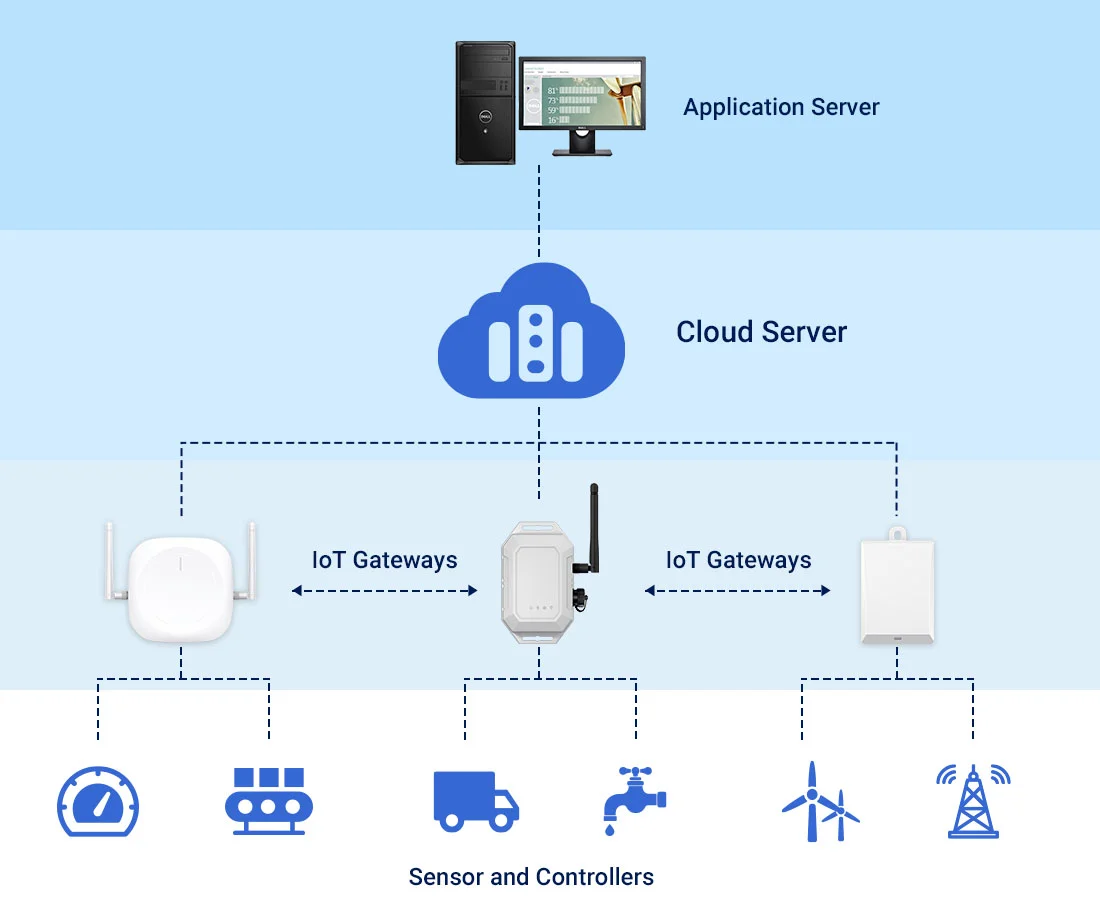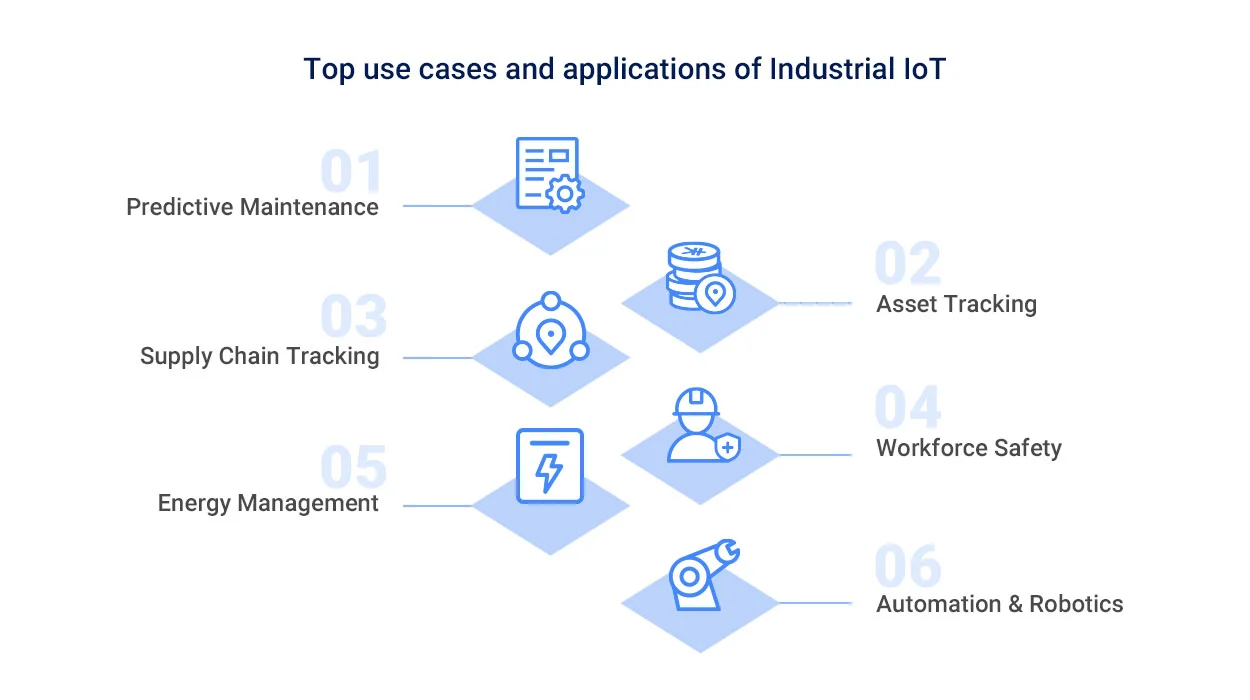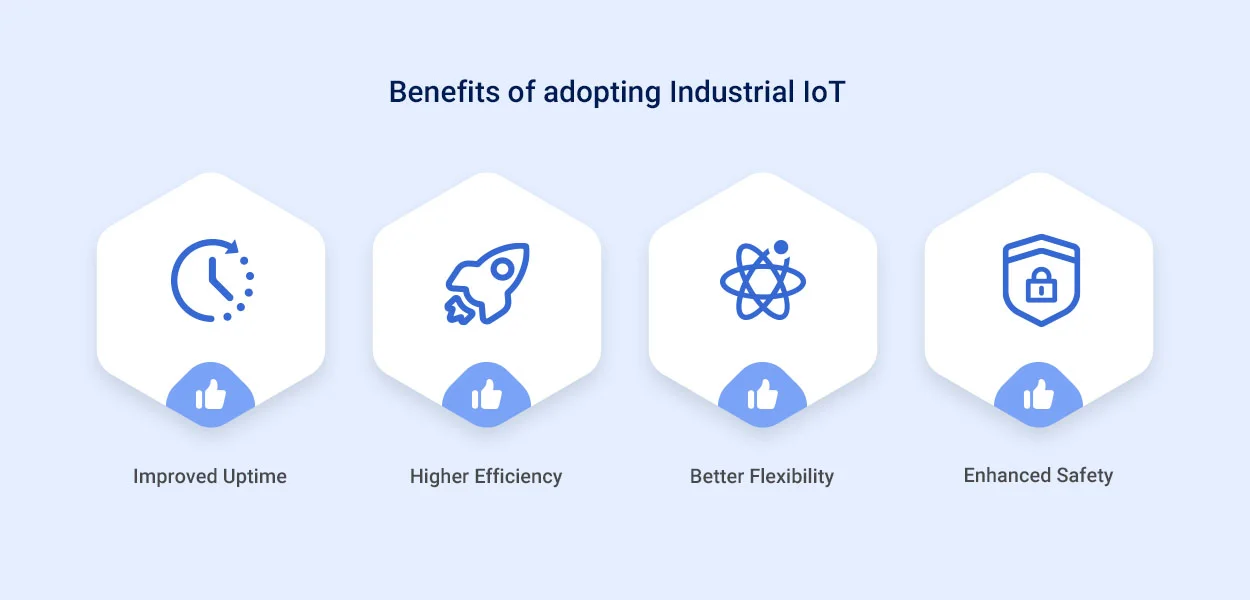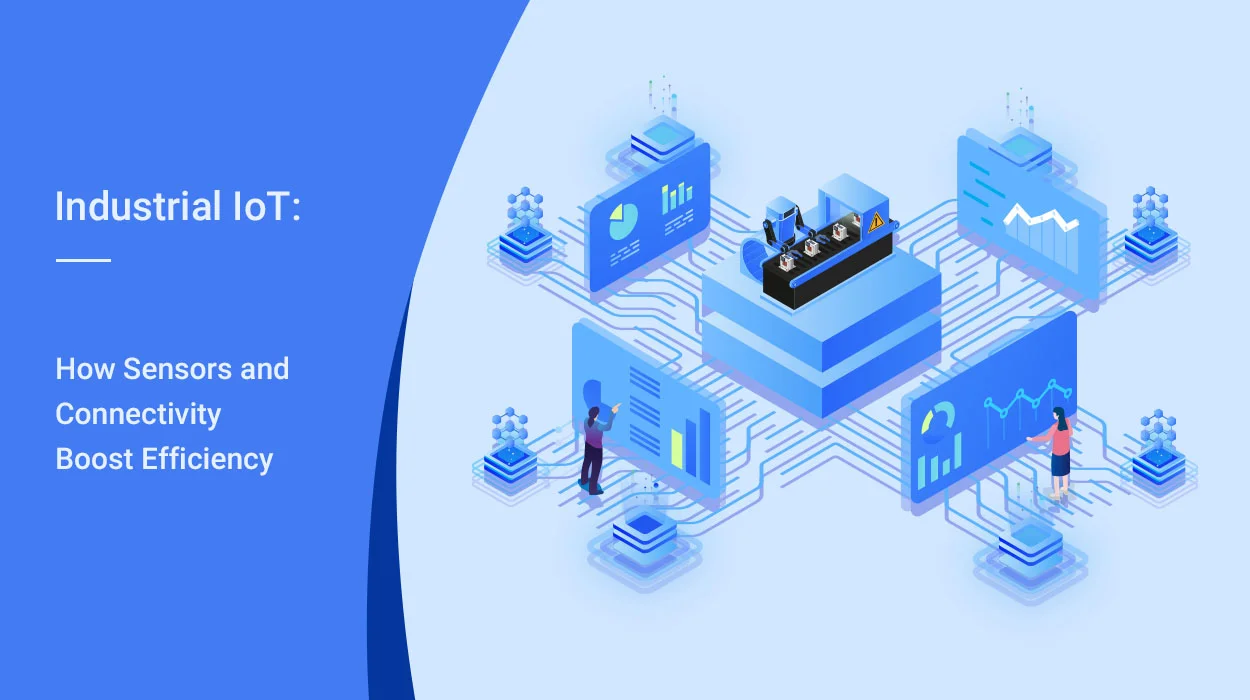Industrial IoT is not just a buzzword, amid the Fourth Industrial Revolution where connectivity and data-driven innovation reign supreme, IIoT takes center stage. It involves leveraging internet-connected sensors, devices, and machines to optimize operational processes for industrial companies.
Grand View Research predicts a potential CAGR of 23.2% for the Industrial IoT market from 2023 to 2030, with a projected size exceeding $1,693.30 billion by 2030. This robust forecast explains why IIoT adoption saw record growth in 2023, despite a turbulent economy. Most industry 4.0 transformations now involve smart factories with connected equipment and integrated data analytics. This guide will get you up to speed on the current state of IIoT, real-world applications, benefits for enterprises and everything in between. Let’s get started!
What is Industrial IoT or IIoT
Simply put, IIoT introduces internet-like connectivity to machines on factory shop floors, vehicles in transportation yards and technology in other industrial sites to unlock data-driven efficiencies. The core principle that enables Industrial IoT connectivity is – what can be measured and monitored can be optimized. IIoT integrates sensors and connectivity and applies them directly to industrial assets such as machinery, fleet vehicles and employee tools.
Imagine a world where machines can communicate seamlessly and the mass volumes of machine data can turn into informed business insights regarding production quality, equipment health, supply chain visibility and more. In essence, Industrial IoT removes blindspots and makes the physical world’s data accessible for smarter industrial automation.
How does Industrial IoT work
An IIoT ecosystem relies on sensors, connectivity, data processing and analytics working in tandem across three levels:
Edge Layer: Consists of mechanical equipment outfitted with Industrial IoT sensors plus hardware like IoT gateways which aggregate and process data flows from industrial assets before transmission via corporate networks or public clouds.
Platform Layer: Centralized computing infrastructure for receiving, storing and analyzing vast data volumes from industrial sites. On-premise servers or cloud-hosted IoT platforms offer capabilities for managing connected devices plus tools to build custom applications. Enable secure data integration with legacy enterprise systems like ERPs as well.
Application Layer: Refers to the use case-specific IIoT software which presents captured IoT data via dashboards and visualizations. Line operators and facility managers leverage these applications to track overall equipment effectiveness, supply chain movements or other business priorities.

Within an overarching Industrial IoT architecture, you will find common supporting communication systems like LPWAN (low-powered wide area networks – think NB-IoT or LoRaWAN) or WiFi which offer expanded wireless coverage across large physical footprints containing heavy machinery.
Key technologies in IIoT architecture
As IIoT deployments become more varied and complex, the enabling technology mix continues to evolve as well. Here are some core pieces you will find in a modern IIoT technology stack:
- Sensors: Sensors connected to industrial assets like motors, compressors and production lines feed IoT connectivity modules with real-time data. These include temperature, pressure, humidity, vibration, voltage etc. which capture different equipment telemetry readings frequently and reliably.
- Connectivity Protocols: IT infrastructure for seamless communication between sensors, gateways and platform/application layers via standards like Wi-Fi, 5G, Bluetooth LE (Low Energy) etc. LPWAN technologies cover the long range and low power requirements of some implementations.
- Cloud and Compute Infrastructure: Leveraging IaaS from Azure, AWS or hybrid models to quickly scalehosted storage, processing and analytical capacities.
- Analytics and Artificial Intelligence: Insights extraction via statistical modeling, machine learning and AI to guide predictive failure analysis, dynamic scheduling, targeted campaign management etc.
Together, these core information technologies form the nuts and bolts for complete IoT enablement across smart factories, connected products and automated supply chains.
What can IIoT do? Top use cases and applications
Across manufacturing, transportation, utilities and other industrial sectors, Industrial IoT applications are improving safety, increasing efficiency and even creating new revenue streams. Here are some of the most valuable use cases:

Predictive Maintenance
Early alerting to equipment failures based on IoT telemetry saves millions annually from avoiding downtime. Think smart pumps in refineries or networked CNC machines in manufacturing plants.
Asset Tracking
Knowing the real-time location and status of capital equipment, fleet vehicles and cargo leads to increased utilization and process improvements.
Supply Chain Tracking
Connected logistics boosts freight journey visibility plus asset use while minimizing waste, theft etc.
Workforce Safety
Wearables for industrial personnel help enforce worker safety policies by monitoring environmental risks or lack of adequate training in equipment operations via integrated platforms.
Energy Management
For utilities and high energy-use facilities like refineries, IIoT enables monitoring usage patterns to reduce waste and improve sustainability.
Automation & Robotics
Insights from IIoT data helps optimize supply chains, warehouse logistics and shopfloor production via smart machines programmed using that intelligence.
Most Industrial IoT solutions focused on effectiveness gains around high value assets while some drove operational efficiency across supply chains. The benefits covered next underline the purely commercial logic behind rapid IIoT adoption by leading enterprises.
Benefits of adopting Industrial IoT monitoring
While exact statistics vary across sources, early IIoT adopters in industries like manufacturing, logistics and utilities seem to benefit in a few key areas:

Improved Uptime: Some sources estimate even 1-2% better asset availability from predictive alerts can save millions annually for heavy industry operators by reducing failures and downtime. The gains keep adding up across all heavy machinery investments in mining, oil & gas, aviation and utilities monitored by IIoT programs.
Higher Efficiency: Granular operational visibility unlocks potential labor cost savings in the single digit percentages in some cases according to preliminary data. Productivity gains from automating manual reporting also likely add efficiency.
Better Flexibility: Dynamic adaptation to fluctuations via IIoT data helps firms handle uncertainty better. The technology seems poised to help with demand forecasting and capacity adjustments.
Enhanced Safety: Early applications of IIoT for worker safety such as gas detection and lone worker monitoring show promise in reducing workplace incident rates, as per industry body estimates.
Clearly for industrial companies, connecting existing investments in mechanical assets simply makes commercial sense given the various pathways for extracting value from resulting data flows.
Industry 4.0 vs IIoT vs IoT – what’s the Difference?
Considering the exploding popularity of connected solutions, you will often come across several technology terms used rather interchangeably. But some definite distinctions exist between IoT, IIoT and Industry 4.0 which are useful to highlight:
IoT refers broadly to a lot of consumer focused efforts like wearables, smart home appliances, connected vehicles etc leveraging embedded sensors plus internet connectivity.
IIoT deals with adapting similar information technologies specifically to unlock efficiencies plus optimize process reliability surrounding heavy industrial assets mentioned earlier – think drilling equipment on oil fields or factory shop floor machinery.
Industry 4.0 represents the ongoing digital transformation for the manufacturing sector – but fueled by underlying IIoT building blocks like equipment sensors and analytics around production line data.
So in summary:
IoT is the mega-trend umbrella
IIoT focuses IoT components into industrial use cases like predictive maintenance
Industry 4.0 centers on the manufacturing sub-sector evolution via IIoT-enabled smart factories and connected processes
Challenges in implementing IIoT
As promising as IIoT sounds, widescale adoption still faces technology and organizational roadblocks like:
- Operational Technology (OT) teams find it hard keeping complex legacy equipment compatible with IoT upgrades or detecting false alerts from sensor readings. Close cross-department collaboration is vital.
- Concerns around insider risks, weak authentication standards or unencrypted data flows stymie cloud migrations critical for analytics consolidation via enterprise IT involvement. Regulatory requirements add complications for IIoT data management as well.
- Certain specialized verticals like pharmaceutical equipment lag in defining IIoT hardware and communication standards universally. The lack of an integrated framework drives complexity and cost.
- Insufficient in-house expertise around data science or full tech stack capabilities slow progress or inflate consulting dependencies. Resolving the skill gaps remains an ongoing challenge.
How MOKO helps with Industrial IoT adoption
Many companies struggle to progress from IIoT proofs of concept to full-scale operationalization due to some technology and other barriers. This is where an experienced industrial IoT device manufacturer like MOKO comes in.
With over 200+ IoT products including various IIoT Bluetooth asset beacons, MOKO brings an agile deployment approach centered around your use cases not just device enablement. Our certified engineers implement sensor instrumentation and communications hardware fully tailored to uncover productivity potential or cost savings specific to your applications. We make the path to digitizing your assets and operations smoother.
Getting started with Industrial IoT solutions
While returns from IIoT adoption speak for themselves, careful planning and disciplined execution is vital in the initial stages when laying the technology foundations within existing industrial environments.
Here are best practice steps to follow:
- Identify Pain Points: Map current operational challenges like recurrent downtimes, supply bottlenecks etc. affecting budget to clearly outline what IIoT investment aims to improve.
- Quantify Potential Impact: Build projections around possible efficiency gains or cost savings from addressing the priority pain points via discussed IIoT use cases.
- Start Small, Scale Well: Keep initial scope limited to high impact equipment or workflows rather than complex whole site instrumentation for smooth pilot testing before enterprise-level expansion. Consider cloud-based trials first.
- Monitor Technology Fit: Confirm sensor readings accurately reflect equipment states or operating conditions. Similarly, verify data flows reliably aggregate on platforms to feed analytics and applications.
- Drive Adoption via Early Results: Showcasing quick operational wins develops stakeholder confidence for securing sustained investments needed to uncover IIoT’s full, long-term potential.
While navigating the shifts needed in connecting legacy physical infrastructure with modern digital platforms, experienced Industrial IoT hardware partners like MOKO help industrial solution operators accelerate time-to-value.
CONTINUE READING ABOUT INDUSTRIAL IOT
























